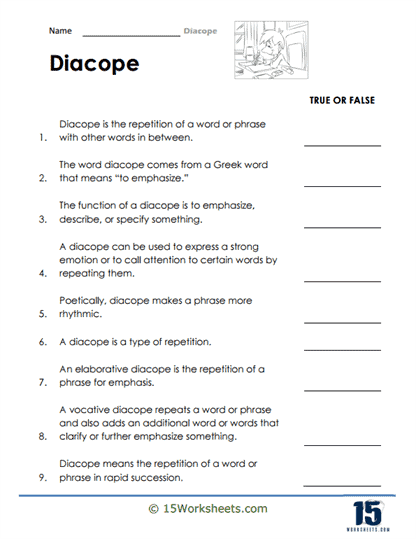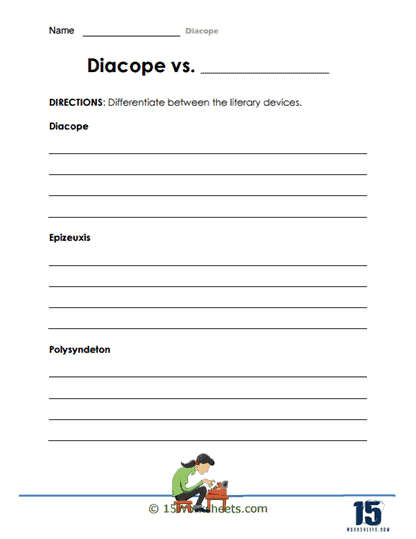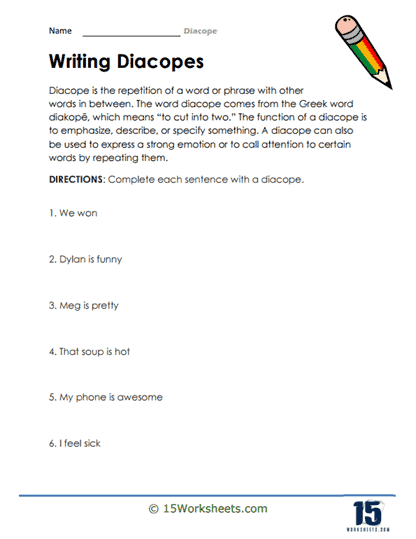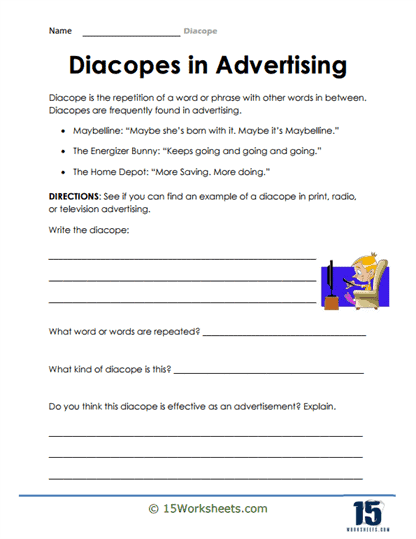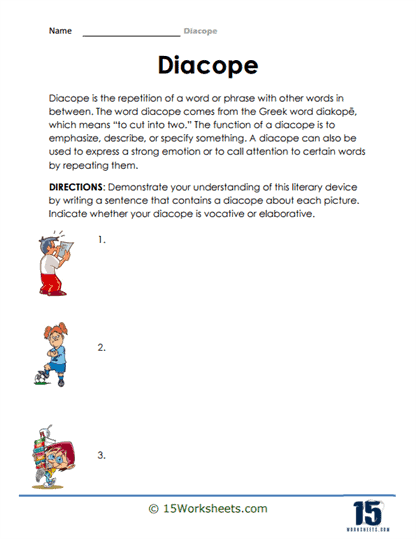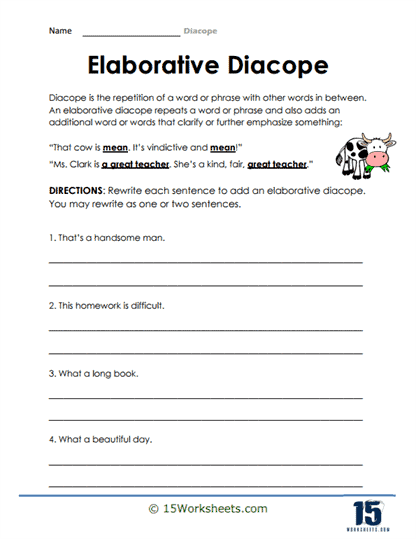Diacope Worksheets
About These 15 Worksheets
Diacope is a rhetorical term derived from the Greek word for “cutting in two.” In literary terms, it refers to the repetition of a word or phrase with one or two intervening words. A well-known example is Shakespeare’s “To be, or not to be,” where “to be” is repeated with “or not” intervening. Diacope can vary in form and function, serving to emphasize a particular theme, enhance the rhythm of the text, or convey emotional intensity. Diacope worksheets are educational resources designed to help students recognize, analyze, and use this rhetorical device in both their analytical and creative writing. These worksheets incorporate a variety of exercises aimed at enhancing students’ language arts and reading skills through the exploration of diacope.
Types of Exercises
Diacope worksheets include a broad spectrum of exercises, each tailored to improve different aspects of language comprehension and usage:
Identification Exercises – Students are given passages from literature, speeches, or other sources and asked to identify instances of diacope. This exercise improves students’ ability to recognize rhetorical devices and understand their function within a text.
Analysis Exercises – Beyond simple identification, students analyze the effect of diacope in the given passages. They may discuss how diacope contributes to the overall meaning, emotion, or rhythm of the piece. This deepens their analytical skills and enhances their appreciation of literary craftsmanship.
Creation Exercises – Students write their own sentences or short passages using diacope, focusing on conveying emotion, creating emphasis, or developing rhythm. This exercise encourages creativity and helps students understand how rhetorical devices can be used to enhance their writing.
Comparison Exercises – These exercises involve comparing passages that use diacope with those that do not. Students reflect on how the presence or absence of diacope affects the text’s impact, thereby understanding the device’s role in effective communication.
Transformation Exercises – Students are given passages without diacope and asked to rewrite them to include this device. Conversely, they may also be asked to remove diacope from passages to observe the difference in effect. This helps students appreciate how subtle changes in language can significantly alter a text’s emotional or thematic resonance.
Multimedia Exercises – Students analyze diacope in various media, such as film, speeches, or advertisements, understanding how this device functions across different forms of communication. This broadens their comprehension of rhetorical devices beyond written text.
Contextual Usage Exercises – These exercises focus on using diacope in specific contexts, such as persuasive writing, poetry, or dramatic monologues, helping students see the versatility of rhetorical devices.
The Benefits of These Worksheets
Practicing with diacope worksheets can significantly benefit students’ understanding of language arts and reading skills:
Enhanced Literary Analysis – By identifying and analyzing diacope in texts, students develop a keen eye for rhetorical strategies authors use to enhance their writing. This skill is crucial for literary analysis, enabling students to dissect and interpret complex literary works effectively.
Improved Writing Skills – Learning to use diacope and other rhetorical devices in their writing allows students to express themselves more effectively. They gain tools to emphasize their points, create rhythm, and evoke emotion in their audience, making their writing more compelling and engaging.
Increased Vocabulary and Expression – Exercises that involve creating and transforming texts with diacope encourage students to explore their vocabulary and experiment with different ways of expression. This not only expands their linguistic repertoire but also fosters a more nuanced understanding of how language can be manipulated to achieve specific effects.
Critical Thinking and Creativity – Analyzing the impact of diacope and experimenting with its use in writing tasks require critical thinking and creativity. Students must consider the device’s effect on the text and how best to employ it to serve their purpose, enhancing their ability to think creatively within the constraints of language.
Understanding of Emotional and Rhetorical Impact – Through exercises that focus on the emotional and rhetorical implications of diacope, students learn how strategic repetition can influence an audience’s perception and emotional response. This understanding is invaluable for both analytical reading and effective writing.
Appreciation for Language’s Rhythmic Qualities – Diacope often contributes to the rhythm of a piece. By working with diacope, students develop an appreciation for the musicality of language, understanding how rhythm can enhance the reading experience and aid in memorization or impact.
Adaptability in Communication – By exploring the use of diacope across various contexts and media, students learn the importance of adapting their language to suit different purposes and audiences. This adaptability is a key skill in effective communication, applicable in both written and oral contexts.
What is the Literary Device of Diacope?
Diacope is a literary device that involves the repetition of a word or phrase with a short interruption by one or more intervening words. This technique is not merely a stylistic flourish but a deliberate strategy used by authors to emphasize a particular point, evoke emotions, or create a rhythmic effect in their writing. The main defining feature of diacope is this repetition with interruption, which sets it apart from other forms of repetition. The power of diacope lies in its ability to draw the reader’s attention to the repeated phrase, thereby highlighting its significance within the text.
Characteristics of Diacope
Emphasis – Diacope is used to place emphasis on the repeated words or phrases, making them stand out in the reader’s mind.
Variety – The intervening words can add variety and complexity to the repetition, allowing for nuanced meanings or shades of emotion to be conveyed.
Rhythmic Quality – Diacope often contributes to the rhythmic quality of a text, enhancing its musicality and aiding in memorability.
Versatility – This device can be employed in various genres and contexts, from poetry and prose to speeches, making it a versatile tool in the writer’s arsenal.
Emotional Impact – By repeating key phrases, diacope can heighten the emotional impact of the text, resonating with the reader on a deeper level.
Examples of Diacope in Literature
Through examples from Shakespeare, Martin Luther King Jr., and Edgar Allan Poe, we see how diacope can be employed across different genres and mediums to significant effect.
Example 1 – William Shakespeare’s “Hamlet”
“To be, or not to be – that is the question.”
In one of the most famous examples of diacope, Shakespeare uses the device to underscore the existential dilemma faced by Hamlet. The repetition of “to be” with the intervening phrase “or not” highlights the contrast between existence and nonexistence, encapsulating the play’s exploration of life, death, and the uncertainty that lies between. This use of diacope serves not only to emphasize Hamlet’s indecision but also to invite the reader to ponder the broader philosophical questions that define the human condition.
Example 2 – Martin Luther King Jr.’s “I Have a Dream” Speech
“Free at last! Free at last! Thank God Almighty, we are free at last!”
Although not from literature, this example from Martin Luther King Jr.’s iconic speech demonstrates the power of diacope in oratory. The repeated phrase “free at last,” separated by the exclamation “Thank God Almighty,” emphasizes the profound longing for freedom and the jubilant realization of that freedom. This diacope creates a rhythmic and memorable conclusion to the speech, reinforcing the message of liberation and hope.
Example 3 – Edgar Allan Poe’s “The Bells”
“Hear the sledges with the bells—
Silver bells!
What a world of merriment their melody foretells!”
Poe’s use of diacope throughout “The Bells” contributes to the poem’s unique sound and atmosphere. By repeating key words with slight variations and interruptions, Poe mimics the sound of ringing bells, creating a sensory experience for the reader. This technique enhances the poem’s auditory imagery, drawing readers into the world Poe crafts with his words, and underscoring the poem’s exploration of the various stages of life through the metaphor of bells.
Effect of Diacope on the Reader
The use of diacope in literature has a profound impact on the reader, affecting both their emotional engagement with the text and their understanding of its themes.
Increased Emphasis and Focus – Diacope draws the reader’s attention to the repeated phrase, ensuring that it remains in their mind long after they have finished reading. This emphasis helps to reinforce the significance of the concept or emotion being conveyed.
Enhanced Emotional Resonance – The repetition inherent in diacope can heighten the emotional intensity of a passage, making the reader feel more deeply connected to the text’s emotional landscape.
Improved Memorability – Texts that employ diacope are often more memorable to readers, as the rhythmic repetition makes the phrases easier to recall. This can be especially effective in speeches or poetry, where the auditory quality of the language plays a crucial role.
Creation of Rhythm and Musicality – Diacope contributes to the overall rhythm and musicality of a text, making it more pleasurable to read or listen to. This musical quality can enhance the reader’s experience, making the text more engaging and dynamic.
Clarification of Themes – By emphasizing key phrases, diacope can also clarify or underscore the themes of a work, guiding the reader towards a deeper understanding of the text’s underlying messages.




